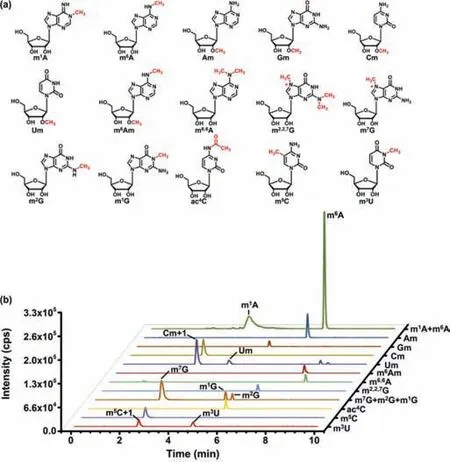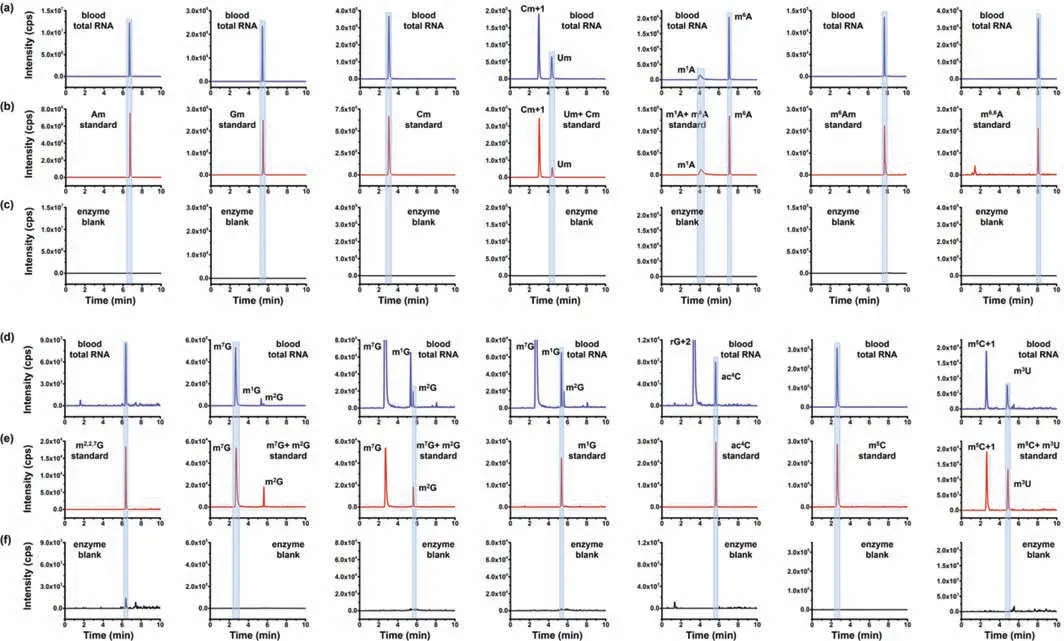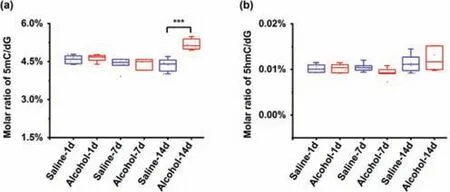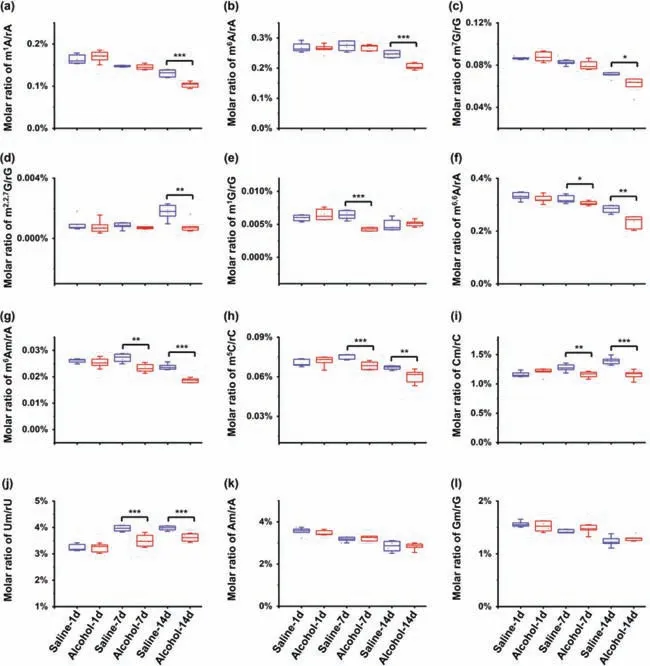Adolescent alcohol exposure alters DNA and RNA modifications in peripheral blood by liquid chromatography-tandem mass spectrometry analysis
Meng-Yun Chen,Zhu Gui,Ke-Ke Chen,Jing-Hui Ding,Jin-Gng He,Jun Xiong,Ji-Le Li,Jie Wng,*,Bi-Feng Yun,c,*,Yu-Qi Feng,c
a Sauvage Center for Molecular Sciences,Department of Chemistry,Wuhan University,Wuhan 430072,China
b Key Laboratory of Magnetic Resonance in Biological Systems,State Key Laboratory of Magnetic Resonance and Atomic and Molecular Physics,National Center for Magnetic Resonance in Wuhan,Wuhan Institute of Physics and Mathematics,Innovation Academy for Precision Measurement Science and Technology,Chinese Academy of Sciences-Wuhan National Laboratory for Optoelectronics,Wuhan 430071,China
c School of Health Sciences,Wuhan University,Wuhan 430071,China
1 These authors contributed equally to this work.
ABSTRACT Alcohol consumption is a critical risk factor contributing to a verity of human diseases.The incidence of alcohol use disorder increases across adolescence in recent years.Accumulating line of evidence suggests that alcohol-induced changes of DNA cytosine methylation(5-methyl-2′-deoxycytidine,5mC)in genomes play an important role in the development of diseases.However,systemic investigation of the effects of adolescent alcohol exposure on DNA and RNA modifications is still lacked.Especially,there hasn’t been any report to study the effects of alcohol exposure on RNA modifications.Similar to DNA modifications,RNA modifications recently have been identified to function as new regulators in modulating numbers of biological processes.In the current study,we systematically investigated the effects of alcohol exposure on both DNA and RNA modifications in peripheral blood of adolescent rats by liquid chromatographyelectrospray ionization-tandem mass spectrometry(LC-ESI-MS/MS)analysis.The developed LC-ESI-MS/MS method enabled the sensitive and accurate determination of 2 DNA modifications and 12 RNA modifications.As for the alcohol exposure experiments,the adolescent rats were intraperitoneally injected with ethanol with an interval of one day for a total 14 days.The quantification results by LC-ESI-MS/MS analysis showed that adolescent alcohol exposure could alter both DNA and RNA modifications in peripheral blood.Specifically,we observed an overall decreased trend of RNA modifications.The discovery of the significant alteration of the levels of DNA and RNA modifications under alcohol exposure indicates that alcohol consumption may increase the risk of the incidence and development of diseases through dysregulating DNA and RNA modifications.
Keywords:Alcohol exposure Adolescence Peripheral blood DNA modification RNA modification Mass spectrometry
A variety of chemical modifications have been identified presence in genomic DNA and RNA molecules of the living organisms[1–4].DNA cytosine methylation(5-methyl-2′-deoxycytidine,5mC)is the most extensively studied epigenetic modification that can regulate gene expression in eukaryotes[5–9].5mC involves in diverse biological processes,including cell differentiation,genomic imprinting,and X chromosome inactivation[10].In 2009,5-hydroxymethyl-2′-deoxycytidine(5hmC),an oxidized derivative of 5mC,was discovered in mammalian genomes and TET(ten-eleven translocation)proteins were identified to be responsible to convert 5mC to 5hmC[11,12].5hmC is an intermediate product participating in the active DNA demethylation pathway[13].In addition,5hmC now has been widely reviewed as the sixth base in genomes and play epigenetic regulation roles in gene expression[14,15].
In addition to DNA modifications,RNA molecules also carry various levels of modifications[2,16–20].More than 100 different kinds of modifications exist in different RNA species from the biological three-domain system[2,6,21–24].Similar to DNA epigenetic modifications,the chemical modifications in RNA molecules can also delicately regulate a variety of biological processes,such as affecting the stability and maturation of RNA[25,26].These modifications in RNA molecules diversify their functions.

Fig.1.The schematic diagram of the timeline for the alcohol exposure and peripheral blood collection from rats.
Alcohol consumption is considered to be a critical risk factor contributing to various human diseases[27].The incidence of alcohol use disorder increases across adolescence[28].Heavy drinking may lead to a variety of diseases,including liver cirrhosis[29],kidney damage[30],pancreatitis[31],cardiovascular diseases[32],and mental disorders[33].Cancer is also closely associated with chronic alcohol consumption[34].Several factors contribute to alcohol-induced cancer development,including the metabolism of ethanol to acetaldehyde and the oxidative stress[35,36].
Accumulating line of evidence suggests that alcohol-induced changes of the level and distribution of 5mC in genomes play critical roles in cancer development[37].Several mechanisms may mediate the effects of alcohol on 5mC in genomes,including reduced folate level and inhibition of the enzymes participating in one-carbon metabolism that ultimately lead to altered level of S-adenosylmethionine(SAM)[38].In addition,alcohol exposure may also cause the changed activity and expression of enzymes involved in DNA methylation(i.e.,DNA methyltransferases)[39],which can dysregulate the 5mC in genomes.As for RNA modifications,however,so far there hasn’t been any study to explore the effects of alcohol exposure on RNA modifications.Therefore,investigation of the associations between alcohol exposure and DNA and RNA modifications should be useful to decipher the mechanisms of alcohol-induced diseases from the epigenetic view.
In the current study,we systematically investigated the effects of alcohol exposure on DNA and RNA modifications(Table S1 in Supporting information)in peripheral blood of adolescent rats by liquid chromatography-electrospray ionization-tandem mass spectrometry(LC-ESI-MS/MS)analysis.The male Sprague-Dawley rats(n = 12;3 weeks old)were purchased from Hunan SJA Laboratory Animal Co.,Ltd.(Hunan,China)and kept in SPF(Specific pathogen Free)animal residence(Wuhan,China).After 12 days of adaptation,these adolescent rats were intraperitoneally injected with either ethanol(1 g/kg,20% w/v;n = 6)or equivalent volume of normal saline(n = 6)with an interval of one day,and for a total of 7 times.To study the effects of alcohol exposure on DNA and RNA modifications,50-200 μL of peripheral blood samples were collected from the saphenous vein in both alcohol treated rats(n = 6)and saline treated rats(n = 6)at day 1,7 and 14.The detailed procedure for the blood collection was according to our previous study[40].The schematic illustration for the treatment with ethanol is shown in Fig.1.
We firstly established the LC-ESI-MS/MS method to detect 5mC and 5hmC modifications in DNA isolated from rat peripheral blood.The enzymatic digestion of nucleic acids was carried out according to the previously reported procedures[41–43].The optimized mass spectrometry parameters are summarized in Table S2(Supporting information).The results showed that both 5mC and 5hmC could be clearly detected(Fig.2a).The retention times of detected 5mC and 5hmC from rat peripheral blood DNA were identical to their standards(Fig.2b).In addition,no single was observed in the enzyme control samples(Fig.2c).These results confirmed that the detected 5mC and 5hmC were from peripheral blood DNA.

Fig.2.Extraction-ion chromatograms of 5mC and 5hmC.(a)5mC and 5hmC detected from peripheral blood DNA.(b)5mC and 5hmC standards.(c)Enzyme blank for 5mC and 5hmC.The enzyme blank represents the sample only containing the enzymes used for digestion and omitting the DNA.

Fig.3.The chemical structures(a)and extraction-ion chromatograms of the standards(b)of 15 RNA modifications.

Fig.4.Extraction-ion chromatograms of RNA modifications of Am,Gm,Cm,Um,m1A,m6A,m6Am,m6,6A,m2,2,7G,m7G,m2G,m1G,ac4C,m5C and m3U.(a,d)Detected RNA modifications from peripheral blood RNA.(b,e)Nucleoside standards.(c,f)Enzyme blank for these RNA modifications.The enzyme blank represents the sample only containing the enzymes used for digestion and omitting the RNA.
We also developed the LC-ESI-MS/MS method for the simultaneous detection of 15 RNA modifications,including 2′-O-methyladenosine(Am),2′-O-methylguanosine(Gm),2′-O-methylcytidine(Cm),2′-O-methyluridine(Um),1-methyladenosine(m1A),N6-methyladenosine(m6A),N6,2′-Odimethyladenosine(m6Am),N6,N6-dimethyladenosine(m6,6A),N2,N2,7-trimethylguanosine(m2,2,7G),7-methylguanosine(m7G),N2-methylguanosine(m2G),1-methylguanosine(m1G),N4-acetylcytidine(ac4C),5-methylcytidine(m5C),and 3-methyluridine(m3U)(Fig.3a and Table S1 in Supporting information).It should be noted that there are two groups of isomeric RNA modifications(m1A and m6A,parent ionm/z282.1 and daughter ionm/z150.1;m1G,m2G,and m7G,parent ionm/z298.1 and daughter ionm/z166.1)and two groups of RNA modifications that have the similar molecular weights(Cm and Um,parent ionsm/z258.1 and 259.1,daughter ionsm/z112.1 and 113.1;m5C and m3U,parent ionsm/z258.1 and 259.1,daughter ionsm/z126.1 and 127.1).After careful optimization of the chromatographic separation conditions,all these isomeric RNA modifications can be well differentiated(Fig.3b),which enabled the simultaneous detection of these 15 RNA modifications.
The optimized LC-ESI-MS/MS method was then employed to determine RNA modifications from peripheral blood.The results showed that all these 15 RNA modifications were clearly detected(Figs.4a and d).In addition,the retention times of these detected 15 RNA modifications from peripheral blood RNA were identical to their standards(Figs.4b and e),while no single was observed in the enzyme control samples(Figs.4c and f),further confirming these detected RNA modifications.
Upon the establishment of LC-ESI-MS/MS method for detecting DNA and RNA modifications,we next quantified these modifications from rat peripheral blood.To this end,we first constructed the calibration curves for both DNA and RNA modifications.As for DNA modifications,a series of nucleoside standards with different amounts ranging from 5 fmol to 10,000 fmol(for 5mC),1 fmol to 100 fmol(for 5hmC),and 1 pmol to 1000 pmol(for dG)were prepared.The calibration curves were constructed by plotting the peak areas of nucleosides versus the amounts of nucleosides.Similarly,we prepared a series of solutions that contain different amounts of RNA modifications mixed with a given amount of isotopic internal standard(rC-13C5).The calibration curves were constructed by plotting peak area ratios of nucleosides/rC-13C5versusthe amounts of nucleosides.The obtained coefficients of determination(R2)were greater than 0.99(Tables S3 and S4 in Supporting information),indicating the good linearities.The limits of detection(LODs)and limits of quantification(LOQs),defined as the amounts of the analytes at signal-to-noise ratio of 3 and 10,respectively,were used to evaluate the detection sensitivities of nucleosides[44].The obtained LODs and LOQs of DNA and RNA modifications were between 0.1 fmol and 10.4 fmol,and between 0.4 fmol and 34.6 fmol,respectively(Tables S3 and S4).
The intra-and inter-day relative standard deviations(RSDs)and relative errors(REs)were calculated at different levels for the evaluation of the precision and accuracy of the method,respectively.The results showed that the intra-and inter-day RSDs for these nucleosides were less than 11.4% and REs were less than 14.4%(Tables S5 and S6 in Supporting information),suggesting that good precision and accuracy of the method.
We next quantified 5mC and 5hmC in peripheral blood DNA from alcohol group and saline group at different time points by the established LC-ESI-MS/MS method.The results showed that the contents of 5mC and 5hmC were basically the same in control group at day 1,7 and 14(Fig.5),suggesting that both 5mC and 5hmC kept relatively stable in this growth stage of 2 weeks.The level of 5mC did not show significant difference between the alcohol group and control group at day 1 and day 7(Fig.5a).However,we indeed observed a significant increase of 5mC level in the alcohol group compared to the control group at day 14(Fig.5a).There was no significant difference of 5hmC level between alcohol group and saline group at any time points(Fig.5b).The results indicated that alcohol may impose an effect on 5mC in peripheral blood DNA.However,it was demonstrated that the level of 5mC was increased only at day 14,indicating that the alcohol exposure under current experimental situation needs relatively long times to have the effect on DNA.A previous report also demonstrated that 5mC level in DNA of peripheral blood of patients with alcoholism was increased compared to controls[45].As DNA hypermethylation is closely associated with abnormal silencing of some tumor suppressors and it’s a precancerous event[46],we reason that the increased level of 5mC in peripheral blood DNA may reflect the possible derangement of epigenetic control,which could eventually lead to the malignant transformation of cells.

Fig.5.Content changes of 5mC(a)and 5hmC(b)in rat peripheral blood DNA upon alcohol exposure.***, P <0.001.
We also used the established LC-ESI-MS/MS method to quantity RNA modifications in peripheral blood.As for the detectable 15 RNA modifications from rat peripheral blood RNA(Fig.4),12 RNA modifications can be distinctly quantified in all these 36 peripheral blood samples from 12 rats(6 for control group and 6 for alcohol group)at the three time points(at day 1,7 and 14).Three RNA modifications(m2G,ac4C and m3U)were detectable,but could not be quantified due to their low abundance.Therefore,here we compared the changes of the levels of 12 RNA modifications,including m1A,m6A,m7G,m2,2,7G,m1G,m6,6A,m6Am,m5C,Cm,Um,Am and Gm.The quantification results showed that the levels of all these 12 RNA modifications didn’t have significant differences between the alcohol group and control group at day 1(Fig.6).However,with the increased alcohol exposure time,we observed the decreased levels of RNA modifications,but the alteration of the levels of these RNA modifications under alcohol exposure was different.Specifically,at day 14,the contents of m1A,m6A,m7G and m2,2,7G exhibited significant decrease in alcohol group compared to control group(Figs.6a–d).At day 7,m1G level was decreased in alcohol group(Fig.6e).As for m6,6A,m6Am,m5C,Cm and Um,we found that their levels were significantly decreased through alcohol exposure at day 7 and day 14(Figs.6f–j).However,the levels of Am and Gm did not show significant difference between the alcohol group and control group at any time points(Figs.6k and l).
The quantification results demonstrated an overall decreased trend of these RNA modifications.Since these RNA modifications mainly are methylated nucleosides,SAM is the universal methyl donor for these RNA modifications[47].We speculated that the concentration change of SAM in peripheral blood may cause the overall decrease of RNA modifications.In addition,it is possible that alcohol exposure could affect the activities and/or expressions of enzymes(methyltransferases and demethylases)responsible for modifying these RNA modifications,which eventually will lead to the changed levels of RNA modifications.Analysis of the metabolites and enzymes that are related to the epigenetic DNA and RNA modifications in future study will further uncover the mechanism for the induced decrease of RNA modifications upon alcohol exposure.

Fig.6.Content changes of 12 RNA modifications in rat peripheral blood RNA upon alcohol exposure.*, P <0.05;**, P <0.01;***, P <0.001.
It has been known that the abnormal contents and distributions of RNA modifications are closely related to human diseases[48,49].Although the underlying mechanisms of the alcoholinduced change of RNA modifications still require further study,the discovery of the significant alteration of the levels of RNA modifications under alcohol exposure in the current study indicates that alcohol exposure may increase the risk of the incidence and development of diseases through dysregulating RNA modifications.We analyzed the RNA modification from total RNA.Deciphering RNA modifications from different RNA species,such as mRNA,rRNA and tRNA,would further promote the understanding of alcohol-induced change of RNA modifications.
In summary,we systematically investigated the effects of alcohol exposure on both DNA and RNA modifications in peripheral blood of adolescent rats by LC-ESI-MS/MS analysis.The quantification results showed that adolescent alcohol exposure could alter both DNA and RNA modifications in rat peripheral blood.In addition,we observed an overall decreased trend of RNA modifications upon alcohol exposure.This is,to the best of our knowledge,the first study reporting the correlation of alcohol exposure with RNA modifications.This study highlighted that alcohol consumption could impose an effect on adolescence through altering the epigenetic DNA and RNA modifications,which should be valuable to elucidate the effects of alcohol-induced diseases from the epigenetic angle.
Declaration of competing interest
The authors declare no competing financial interests.
Acknowledgements
The work is supported by the National Natural Science Foundation of China(Nos.22074110,21635006,21721005,31771193),and the Fundamental Research Funds for the Central Universities(No.2042021kf0212).
Supplementary materials
Supplementary material associated with this article can be found,in the online version,at doi:10.1016/j.cclet.2021.08.094.
 Chinese Chemical Letters2022年4期
Chinese Chemical Letters2022年4期
- Chinese Chemical Letters的其它文章
- Key progresses of MOE key laboratory of macromolecular synthesis and functionalization in 2020
- Small nanoparticles bring big prospect:The synthesis,modification,photoluminescence and sensing applications of carbon dots
- Cell membrane-coated nanoparticles for immunotherapy
- Diketopyrrolopyrrole-derived organic small molecular dyes for tumor phototheranostics
- Exosome based miRNA delivery strategy for disease treatment
- Recent advances in targeted stimuli-responsive nano-based drug delivery systems combating atherosclerosis
